1973 Ford Pinto Squire: Brougham on a budget?

I can hear it now: “Klockau, we get it, we know you like Broughams, but a Pinto? Come on!” It’s OK, I haven’t gone off my rocker, but some of these first subcompacts from Ford, particularly the Squire wagon and the coupes and hatchbacks with the LDO (or Luxury Decor Option) package, definitely gave off a bit of a Brougham vibe.

But no one’s going to confuse this with an LTD, Marquis, or Continental Mark IV. I mean, it’s a Pinto, for crying out loud. But in 1973, when this baby blue Squire came off the line, Lee Iacocca was essentially running the show despite his name not being on the building, and one thing Lee loved was Brougham.

Yes, Brougham. Chrome, whitewalls, extra side trim, luxury wheel covers, the whole bit. And don’t forget the simulated wood! And, of course, on the Pinto Squire it was inside and out, thanks to the Di-Noc festooned flanks.
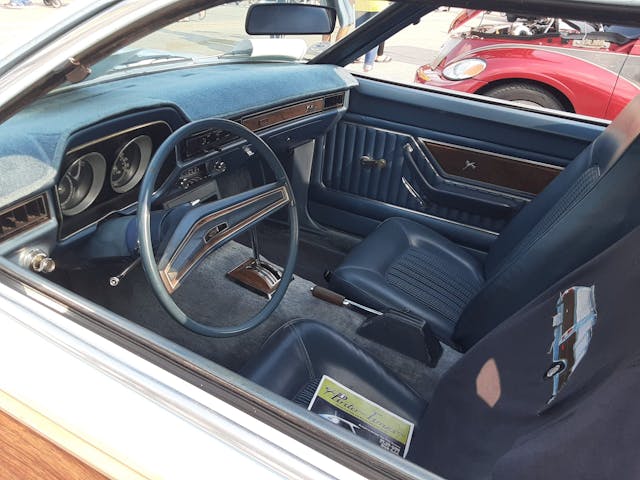
Ask folks of a certain age about the Ford Pinto, and you could either get an earful about a rust-bucket lemon, or about a car that just kept on running for years, or about certain yellow journalism from the ’70s that singled the tiny Ford out for a design that many other contemporary cars also had.

If you were born before 1980 (the last year the Pinto was made, incidentally), odds are someone either had one, knew someone (or several someones) who had one, delivered pizzas in one, went on crazy college road trips in one, and so on.
Once upon a time they were everywhere, thanks to a cheap price and the increasing interest in smaller cars as the 1970s dawned.
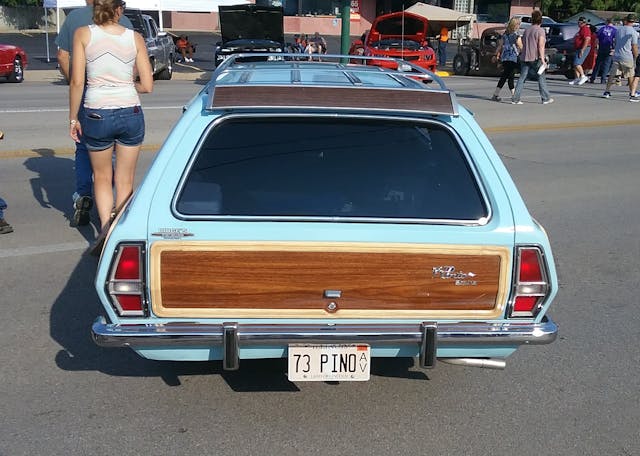
Along with archrival Chevrolet, the first Ford subcompact came out for the 1971 model year. Initially offered only as a two-door sedan or two-door hatchback (termed “Runabout” by Ford marketing), it was base priced at $1919 ($13,867 today); a Runabout was $2062 ($14,900).

It sold like dollar beer at a baseball game—288,606 sedans and 63,796 runabouts were delivered for the model year. The runabout/hatchback was not initially available; it debuted several months later at the 1971 Chicago Auto Show.
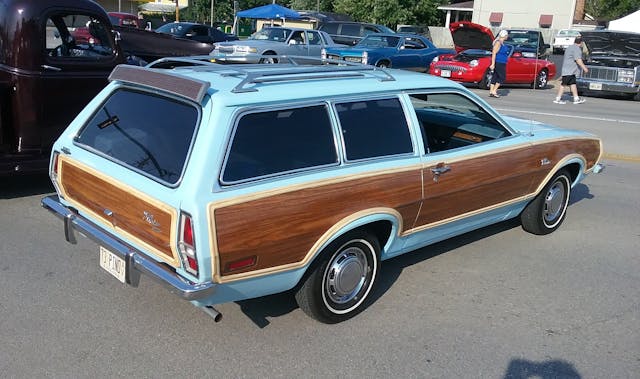
But the big news for the 1972 Pinto was the addition of a two-door station wagon. It immediately became a healthy seller. Initially offered at $2293 ($16,054), 101,483 were sold for the ’72 model year. That same year, 181,002 sedans and 197,920 runabouts were produced.
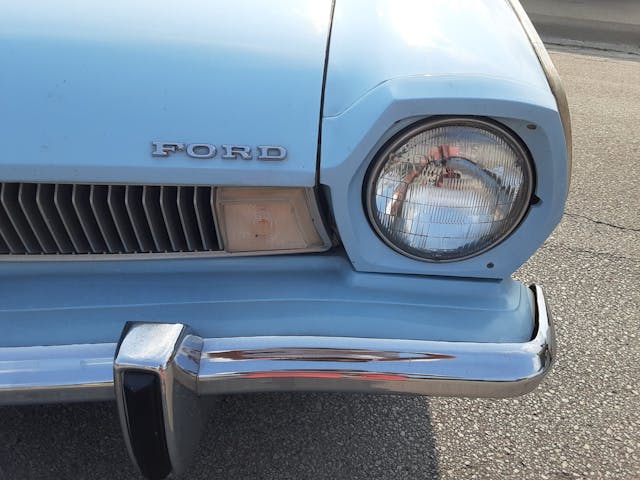
As previously mentioned, from the beginning lots of dress-up and comfort/convenience options were available, but don’t get the idea this could be optioned to mini-LTD specifications. You couldn’t get power windows, power locks, or even wire wheel covers.

But you could get the Cruise-O-Matic automatic transmission, full wheel covers, whitewall tires, a leather wrapped steering wheel, electric rear window defroster, dual color-keyed sport mirrors, metallic “Glow” paint choices, and an AM/FM stereo.

But the real flossy version was the Luxury Decor Option, which was available on all Pintos and included a vinyl insert body-side protection molding, full wheel covers, bright wheel lip moldings, and bright rocker-panel moldings.

But inside was where you really saw the difference, with pleated cloth or vinyl trim, fancier door panels with wood-tone trim, cut-pile carpeting, deluxe steering wheel, wood-tone-accented shift lever and parking brake lever, rear seat ash tray (trust me, this was a big deal in 1973), and more.

But wait! As someone rather famous one said, there’s even more! If you ponied up (pardon the pun) for the Squire option, you got as nice a Pinto as was possible in 1973.
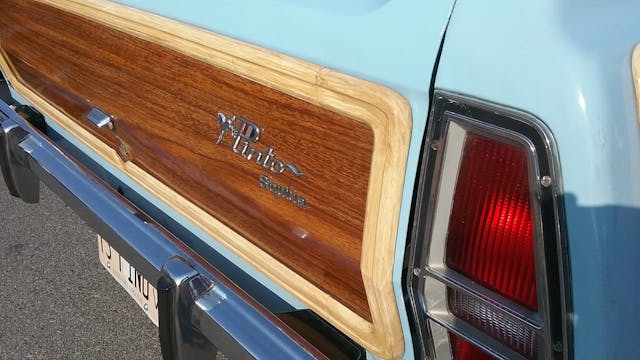
As the 1973 Ford Wagons brochure said (of course I have a copy), the Squire Option was “a beautiful complement to the Pinto Wagon, and a Ford Wagonmaster innovation.” I’m not sure where the innovation was, as in 1973 you could get a Vega Estate across town at your local Chevy dealer. But who knows what the FoMoCo marketeers discussed with their lunchtime martinis?

At any rate, the Squire included all of the Pinto Accent Group and Luxury Decor Group features, plus the woodgrain-clad sides and liftgate. To that, one could also add optional SelectAire air conditioning and tinted glass for an extra plush Pinto.

A 1973 Pinto wagon started at $2319 ($15,285), though naturally the Squire goodies and other options would bump that tally higher. This was the year the Wagon became the most popular Pinto, with an impressive 217,763 sold, along with 150,603 Runabouts and 116,146 sedans. That would dip some in a few years, but as previously mentioned, the car made it all the way to the 1980 model year before being replaced by the front-wheel-drive Escort. And yes, a Squire option was available to the end.
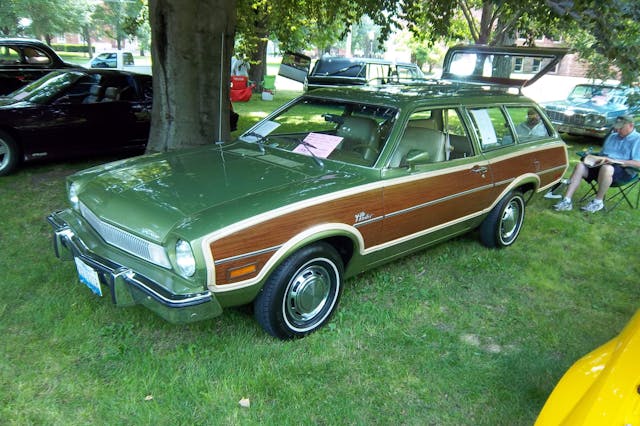
Escorts and Pintos, sigh. They used to be absolutely EVERYWHERE, but you’d be hard-pressed to find one today. The cheap and cheerful price, 1970s-style rustproofing (or rather, the lack thereof), and the fact that most of these cars had the bark beaten off of them means there are few survivors today despite extremely impressive production. I’ve only seen two in person at shows, the Light Blue ’73 featured today and this Clark Griswold-approved green ’74.

I first saw the green one at the 2013 Railroad Days show in Galesburg, Illinois. Back then it was held in Standish Park, near the Knox County Courthouse, and was a great location. Though it’s since moved to Main Street, it is still a great annual event that draws a bunch of interesting cars.

I see both Pintos at several shows a year, including the most recent 2022 show season. They always make me smile. I just like the uncommon stuff, I guess; I’ll walk past a row of red Corvettes and resto-mod Camaros to look at a Cordoba, Granada … or a Pinto!
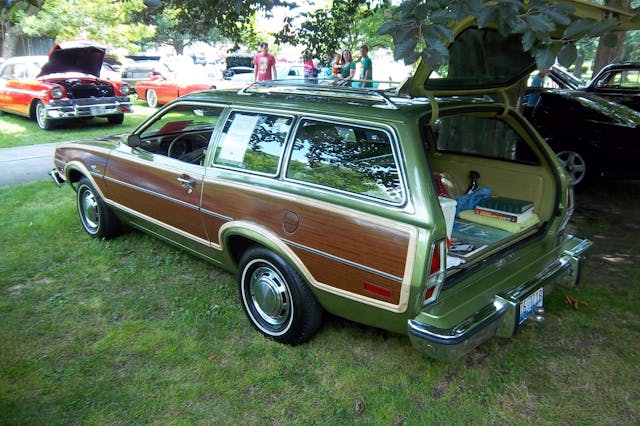
And while I am still atop my soapbox, may I say that if we’re apparently no longer going to be getting many station wagons or sedans from manufacturers anymore, can we at least get some wood sides for our combovers? Please?



My Grandmother had the green Squire for many years. It was pristine into the 80s with less than 10K miles on it when someone talked her into selling it. I recall a terrifying ride that cemented that car in my memory.
Great cars; had a ’72 Wagon. ’74 Wagon, and a ’77 Hatchback, wouldn’t mind having another Wagon now.
It aint FoMoCo Fit and Fiinish, but maybe a faulty protractor or something …those little curly-que cutouts on clear plastic math rulers; whatever, that faux wood sort-of-around the front wheel housing looks as though the fender stopped suddenly and faux wood kept on going.
Hey love is blind! I d not recall fond memories about Pintos as a kid.
GOT TO PICK OUT MY NEW 1973 FORD PINTO RUNABOUT FROM HORNE FORD IN FLORENCE , SC LOVE THE CAR HAD IT FOR YRS.
Bought a ‘73 Pinto wagon (green like the photo) with 2300 miles on it in 1974. Drove it until 1982 when I bought a new Pontiac LeMans (a real lemon). Lots of fond memories of the Pinto. Could change oil and filter without ever crawling under the car. Needed to replace plugs and points every 3000 miles without fail or it would quit running. Quit running in ND on I-29 at about midnight. I was installing plugs and points when the highway patrol stopped and asked me, “What the hell are you doing.”
My best friend’s Mother In Law had a green Wagon with an Automatic and a Radio. It was used for shopping, Doctor Appointments and so on. She was an older woman. When she passed, the car was given to her Son who drove it until it finally died at 178,000 miles.
Tom, I’m with you about the charm of once common cars that you don’t see anymore. One year while attending the Syracuse Nationals car show, the most interesting vehicle I saw was a 1967 AMC Marlin fastback in parking lot. I would also walk past the sea of Camaros, Mustangs, and Chevelles to view something less popular such as a station wagon. Those Pintos were in amazing condition. They didn’t last very long up here in Central New York.
My first company car in 1976 was a yellow Pinto wagon. It was a corporate hand-me-down so that my team mate could get a new car. The wagon provided the room needed for the equipment I had to carry around. It had a cable-operated clutch. The cable broke one day while I was in Atlanta traffic on I-285. I used the starter motor to pull it to the breakdown lane. Put about 25k on it in the 1 year I drove it.
IIRC, in Hot Rod magazine, someone at Ford floated the idea of calling it “Country Squirt”, but, alas and alack it didn’t come to be…
My parents had this exact color Squire, which became a pass-around to whichever of my siblings had a car problem. I was its last owner, trading it in on a new 1980 VW Jetta (for $100). My wife’s Fiat 128 and my Sprite were on their last legs, and I had bbq’d a yellow Type 3 wagon because of bad advice, and fecklessness on my part.
I memorialized the Pinto, Fiat and Sprite in an alphabet book a few years back. Abecedarium Automobilium on Etsy.
I had a new Pinto Squire in 1974 and put 98k on it in 3 years. I’d love to get another one now but nice Squires are around $20 thousand and regular wagons $12k +/-. Oh well, I’m just thankful to have some of the other cars I bought new like my ‘78 Thunderbird, ‘85 Mustang 5.0 LX convertible, ‘91 Escort wagon with 313,378 miles, 2000 BMW Z3 with 158k, etc.
Had a 72 4 speed wagon. At over 150,000 miles still going strong when I totaled it. A local body shop bought it from the insurance company and his wife continued to drive it. I would bet that 100% of the engine failures mentioned here were due to neglected timing belts. These belts had a very short lifespan compared to timing chains or later designs but in comparison they were also incredibly easy and cheap to replace.
Dad had the Mercury Bobcat version, with the Country Squire 2-door wagon treatment. He loved it. Thought it was the perfect, functional runabout, able to haul small loads and fit anywhere. Fortunately, it was white so not a total embarrassment to a high school son.
My dad bought a brand new ’71 and it came down to me when I was 17, as long as I made the payments. I inverted the back wheels so that they gave it a wider track and sort of looked like a hot rod and I didn’t care that I could only tighten a couple of threads on the lug nuts. It then went to my sister after I bought a Corvair Greenbriar van. She drove it several years and sold it to a neighborhood guy for $200. As long as I knew him, he was the last guy to drive any car he ever owned. Poor Pinto.
i seem to remember that when new we always called them country squirts